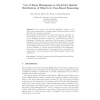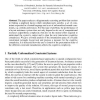287 search results - page 7 / 58 » Mental Models in Spatial Reasoning |
AI
2008
Springer
14 years 1 months ago
2008
Springer
Abstract. In the context of the RoboCup Simulation League, we describe a new representation of a software agent’s visual perception (“scene”), well suited for case-based reas...
SPATIALCOGNITION
2000
Springer
13 years 11 months ago
2000
Springer
The paper analyzes a diagrammatic reasoning problem that consists in finding a graphical layout which simultaneously satisfies a set of constraints expressed in a formal language a...
IADIS
2004
13 years 8 months ago
2004
Inductive reasoning is one of the important characteristics of human intelligence. Researchers have regarded inductive reasoning as one of the seven primary mental abilities that ...
ICRA
2010
IEEE
13 years 6 months ago
2010
IEEE
- This work presents the development of a brain computer interface as an alternative communication channel to be used in Robotics. It encompasses the implementation of an electroen...
ECAI
2010
Springer
13 years 4 months ago
2010
Springer
Bipolarity is an important feature of spatial information, involved in the expression of preferences and constraints about spatial positioning or in pairs of opposite spatial relat...


